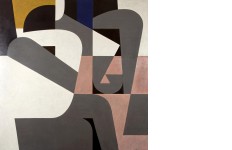Engraving 46Gouache 2Tempera 14Oil painting 226Οil pastel 34Acrylic 146Sculpture 51Egg tempera 157Drawing 249Mixed media 82Watercolor painting 7Collage 2
Special Information for the Artist
TITLEEroticon
MEASUREMENTS (cm)Height : 200
Width : 200
USED MATERIALSOil painting (Oil on canvas)
SIGNATUREOn The Reverse
CHRONOLOGY01-01-1990
AUTHENTICITY CHECKNot checked

PROVENANCE:
Zoumboulakis Galleries, Athens.
Private collection, Athens.
EXHIBITED:
Athens, Zoumboulakis Gallery, Moralis, March 1992, no. 10 (illustrated).
LITERATURE:
Moralis, Critical text Chr. Christou, Adam Editions, Athens 1993, p. 242 (illustrated).
Sima magazine no. 7, March-April 1992, p. 29 (illustrated).
Reviewing Moralis's work in 1992, Athens National Gallery Director M. Lambraki-Plaka noted that "in his recent paintings, Moralis seeks a geometric ideogram for love."1 This poignant and poetic remark perfectly suits the artist's wonderful Eroticon, which was included in his 1992 one-man show in Athens. Prefacing the exhibition catalogue, gallery owner Peggy Zoumboulaki noted: "I first saw these works at the end of the summer of 1991 on the island of Aegina, at Moralis's sun-drenched seaside house designed by his friend, the architect Aris Konstandinidis. Seeing these works, which overflow with eroticism and love for the female body, one feels that nothing is superficial, that the artist has lived every moment of his work. By eliminating any superfluity that might reveal pointless sentimentality, Moralis reaches the meaningful essence."2
When the show opened it created a stir. In his review -one of the most insightful essays ever written on the artist, Professor D.N. Maronitis noted: "I visited the Zoumboulakis gallery the morning after the opening, before the spots, which often seem like interrogating the paintings with their intense light, were lit. And suddenly I saw Moralis's works looking out with their clear vision, dominating with their proud solitude. His paintings take us directly to the wondrous world of pure vision, which emerged, however, from the world of touch. That's a way to somehow explain the geometry of bodies and colours that constantly abstract and are abstracted to reach their final shape and immutable tone."3
Demonstrating solid structure, purity of form, poetic abstraction, disciplined rhythm, harmonious proportions, inspired synthesis of gently flowing curves and ingenious interplay of active and passive themes, Eroticon achieves a striking balance between erotic passion, lyrical feeling and intellectual thought. As Nobel Laureate Odysseus Elytis once noted, "Moralis was always driven by a longing for the monumental, bestowing even on his most sensual conceptions a feeling of mystery and a Biblical sense of the sacred. Memories and encounters are repeatedly distilled until they blend into forms of great simplicity and precision. The earth of Aegina and the bodies of young girls emerge with the dampness of the sea, like magnified fragments of ancient Greek vases or miniature frescoes from a bygone place of worship."4
True to his classical Greek heritage and yet utilizing a formal vocabulary balanced to the scale of modern sensitivity, Moralis seeks the realization of a classical ideal, the discovery of a universal measure for logos and pathos. "Moralis uses abstraction to isolate the core of human existence, to create through his art a language of symbols. He paints the Aegean Sea, the isle of Aegina, the union of human bodies: evocative forms that echo age-old memories, freed from the burden of their physical existence."5 On summer afternoons in his island studio, where Eroticon was created, some close friends had the privilege to first see the master's latest works. "Though daylight started to wane, another glow lit the atmosphere, tenderly embracing his 'doric' paintings."6
By focusing on the essential, Moralis expresses what is permanent and universal. "In his fragmented and elliptical figures and in the wealth of his linear compositions and chromatic statements, he neither describes nor narrates but expresses and interprets the forces of creation. Above all else, his paintings are at once erotic, profoundly sentimental and poetic. In them one may trace a progress from earthly to heavenly love, from the sensual aspects of the subject to the universal and eternal, to the metaphysical and transcendental."7
1. M. Lambraki-Plaka, Parthenis, Ghika, Moralis [in Greek], To Vima daily, 27.9.1992, p. B4.
2. P. Zoumboulaki, preface to the Moralis exhibition catalogue, Zoumboulakis Galery, Athens, 1992.
3. D.N. Maronitis, The Gift of Vision [in Greek], To Vima daily, 15.3.1992.
4. O. Elytis, preface to the Moralis exhibition catalogue, Iolas-Zoumboulakis Galerie, Athens 1972.
5. Y. Bolis, Yannis Moralis [in Greek], Ta Nea ed., Athens 2007, p. 79.
6. See C. Capralos, Autobiography [in Greek], Athens 2001.
7. C. Christou, Moralis, Adam editions, Athens 1993, pp. 20, 33, 34.